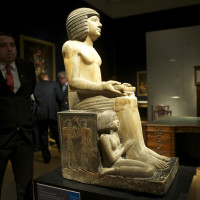Egypt’s government has asked its citizens to help raise nearly $25 million to buy back an ancient statue sold at auction by Christies in London last year.

Antiquities Minister, Mamdouh el-Damaty, called on Egyptians worldwide to donate money to help return the 4,500-year-old “irreplaceable masterpiece” to its native country, according to The Cairo Post.
The painted limestone statue of an Egyptian royal scribe called Sekhemka sold at auction in July 2014 to an unknown buyer for nearly $20 million by Northampton Museum to help fund its renovations. The sale has angered Egyptian authorities and raised a number of ethical and legal questions. The prized piece might “never be seen on public display again” if purchased by a wealthy private collector when an export ban imposed on the statue expires at the end of August, el-Damaty warned during a press conference at Egypt’s antiquities ministry in Cairo.
“The sale of the statue is an indelible stain on the museum’s reputation and is a moral crime against world heritage in general and the Egyptian heritage in particular,” he said, adding: “I am calling all Egyptians around the world to help Egypt to preserve its ancient Egyptian heritage and to collect the required fund to buy the Sekhemka statue.”
El-Damaty also announced that Egypt has halted all its dealings with Northampton Musuem to protest its “unethical role” in the sale of the Sekhemka statue. It was believed to be the first time a museum had sold an Egyptian antiquity. El-Damaty said these historical pieces are given to museums “to spread information about civilization, heritage, arts and culture. Therefore, the final resting place for any antiquity is the museum.”
“What this museum is doing is considered an ethical crime against human and Egyptian heritage,” el-Damaty told the press conference.
The Sekhemka statue belonged to an ancient Egyptian court official and scribe during the fifth dynasty from 2,400 B.C. to 2,300 B.C. It was later found during excavation from the Sakkara archaeological site, about 16 miles south of the Giza pyramids. The statue was then acquired by Spencer Compton, the second Marquis of Northampton, during his trip to Egypt in 1849-50. It was later given to the Northampton Museum by the third or fourth Marquis prior to 1880.










